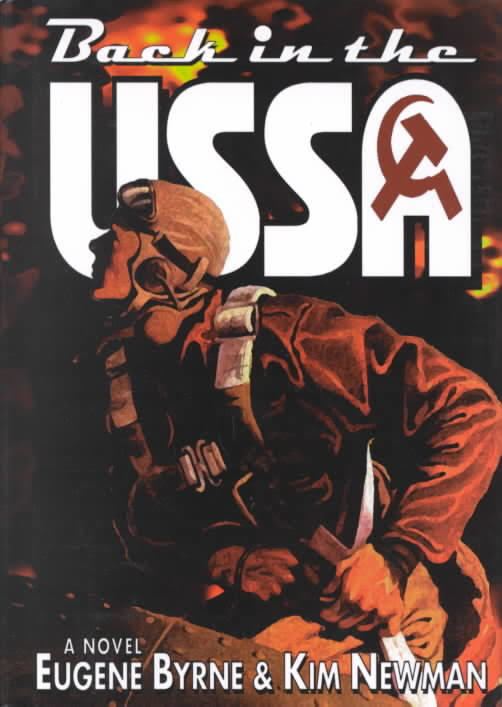7.8 /10 1 Votes7.8
Country United States Publication date September 1997 Pages 356 Originally published September 1997 Page count 356 | 3.9/5 Goodreads Language English Media type hardcover ISBN 0-929480-84-8 Cover artist Arnie Fenner | |||||||||||||||||||||||||||||||||
 | ||||||||||||||||||||||||||||||||||
Similar Kim Newman books, Alternate history books, Other books | ||||||||||||||||||||||||||||||||||
A tea party song back in the ussa a parody song on debtors prison blues
Back in the USSA (ISBN 0-929480-84-8) is a collection of seven short stories by Eugene Byrne and Kim Newman, which was published in 1997 by Mark V. Ziesing Books. The stories are linked through their setting, an alternate history of the twentieth century in which the United States experienced a communist revolution in 1917 and became a communist superpower, whereas Russia did not. Six of the stories first appeared in Interzone magazine, and the concluding story in the sequence, "On the Road", was written especially for the collection.
Contents
- A tea party song back in the ussa a parody song on debtors prison blues
- Mstrkrft back in the ussa exchange master mstrd01
- Background
- Stories
- Overview
- Publication history
- References
Mstrkrft back in the ussa exchange master mstrd01
Background
The stories imagine that instead of Alexander II of Russia being assassinated in 1881, in 1912, Theodore Roosevelt was reelected President of the United States as the Progressive Party candidate, only to be assassinated on December 19, 1912 before taking office when personally breaking a labor strike with the help of the Rough Riders at the Chicago Union Stockyards by the sharpshooter and exhibition shooter Annie Oakley. Following this, his vice president, Charles Foster Kane takes power, and gradually leads the United States into greater levels of oppression, class division and bureaucratic incompetence and corruption – including an earlier entry into the First World War in 1914 and the assassination of his rival candidate, Woodrow Wilson, during the 1916 election campaign.
Gradually, by 1917 the United States is unstable politically and socially, with overwhelming civil unrest stemming from the massive (and seemingly pointless) loss of American lives in the mud of the Western Front and the increasing gap between the wealthy 'robber barons' and the poor workers, and the massive corruption and exploitation this has resulted in. The Socialist Party of America led by Eugene V. Debs gains increasing support, and soon the unrest has led to a Second American Revolution and Second American Civil War, following which Kane is ousted from the White House, overthrown, and executed for treason. Afterwards, a new socialist order, led by Debs, takes over.
The early idealism of this change is misplaced, however; upon Debs' death in 1926, power is seized by Al Capone (an obvious parallel to Joseph Stalin, just as Debs is used to mirror the achievements of Vladimir Lenin), who proceeds to rule over the USSA with a brutal, repressive fist of iron, establishing a cult of personality around himself, exiling and executing his political rivals and ruling the country more brutally and ruthlessly (and incompetently) than any of the robber barons who were previously deposed. Gradually, following the Second World War, the Cold War between the USSA, the United Kingdom and a semi-constitutional monarchist Russian Empire, and the war in Indo-China (a Vietnam War-like affair in which armies from Russia and Great Britain attempted to support a somewhat democratic regime under attack from USSA-backed Communist guerillas), the USSA begins to stagnate economically and socially, before finally collapsing into separate, bickering nations by 1991, leading to an uncertain future for both the former USSA and the rest of the world.
Stories
Overview
As is common with much of Newman's work, the stories feature a great deal of intertextuality, both with actual historical events (many of the stories feature events which mirror actual events that took place within the real twentieth century, in particular the 1917 Russian Revolutions and the Vietnam War) and with popular culture. The stories are significant in that they feature famous fictional characters (particularly from American and British texts) interacting with real personages; President Charles Foster Kane, for example, is the main character from Orson Welles' 1941 motion picture Citizen Kane, whereas Tom Joad — hunted by real-life law enforcers Elliot Ness and Melvin Purvis in 'Tom Joad' — is the protagonist of John Steinbeck's The Grapes of Wrath. Hannibal Lecter appears as the head of the Department of Health, and John Rambo helps train Vietnamese Communists. Rambo is played in a film by Raymond Massey. Brigadier Lethbridge-Stewart appears as a British officer in Teddy Bears' Picnic (though Doctor Who is referred to as fiction in the same story), as do Nigel Molesworth and Basil Fotherington-Thomas.
